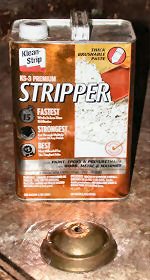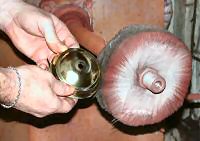Cleaning and Polishing Brass
Clock weight shells, pendulum bobs, case parts, dials and bezels all
become corroded on the surfaces, especially if frequently handled.
Cleaning brass is not difficult. Many polish cremes are available and
they work well. However, refinishing brass, so that it keeps its shiny
appearance for years, requires practice and experience. A brass piece
from a lamp was used for the demonstration on this page.
 |
The part is cleaned with detergent and then dipped in muriatic acid for
about one minute. Muriatic acid is dilute hydrochloric acid. Using a
powerful and dangerous acid like this should only be left to a
professional. The acid reacts with the metal oxide, dissolving the
oxide into solution. However, it can also react with the metal itself
and dissolve it, so the part should be removed after a short time.
(Vinegar, or ethanoic acid, works well and is much safer, though
results will take more than one minute. Ammonia solution also works
well, and it will not react with the metal itself.) Do everything in a
well ventillated area.
 |
The acid is removed by rinsing thoroughly in water. The part is dipped
into a buffer like sodium bicarbonate solution and then rinsed again
thoroughly in water. (A mild base like ammonia solution could also be
used in place of the buffer). Apply stripper with a paintbrush and
leave for five minutes. Rinse again thoroughly in water.
 |
Brush the surface thoroughly, dipping the part in water with detergent
while brushing. A brass wire wheel like this one makes the job easy.
 |
Polishing takes place in two steps. First polish with a cotton wheel
using tripoli (a fine abrasive compound). Clean off the residue with
lacquer thinner (other solvents can also be used).
 |
Polish the surface to a mirror finish with another cotton wheel using
rouge (a very fine abrasive compound). Again, clean off the residue
with lacquer thinner.
 |
Darren finishes the job with a layer of lacquer. He used a fine spray
of lacquer mixed with some lacquer thinner. For objects which are
handled frequently, two layers of lacquer is recommended. Allow the
lacquer to dry.
 |
They're really nice guys. Honest!
 |
This clock dial pan and bezel have been cleaned and are ready to be polished and lacquered.
 |
These carriage clock parts have been cleaned and polished, and are
ready to be lacquered. The next photo shows the clock afterwards.
 |
 |
I would like to thank Darren Wicker and the good folks from Austin
Brass for this demonstration. They refinished and repaired brass, copper
and silver products, such as musical instruments (trumpets, trombones,
French horns, etc.), lamps, bed frames, etc. Repairs included removing
dents, loosening sticky valves, and soldering broken parts.
 |
Clock Repair Main Page
Escapements in Motion
Links Page